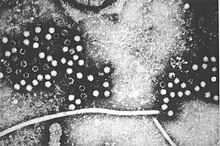
Back Hepatitis E ACE التهاب الكبد هـ Arabic التهاب الكبد E ARZ Hepatit E Azerbaijani হেপাটাইটিস ই Bengali/Bangla Hepatitis E Catalan Hepatitis E German ހެޕަޓައިޓިސް އީ DV Hepatitis E Spanish هپاتیت ئی Persian
| Hepatitis E | |
|---|---|
 | |
| Hepatitis E virus | |
| Specialty | Infectious disease, Hepatology |
| Symptoms | Nausea, jaundice[1] |
| Complications | Liver failure[1] |
| Causes | Hepatitis E virus (HEV)[1] |
| Diagnostic method | Blood test[1] |
| Differential diagnosis | Hepatitis A[2] |
| Treatment | Rest, ribavirin (if chronic)[1] |
| Frequency | 28 million worldwide (2013)[3] |
Hepatitis E is inflammation of the liver caused by infection with the hepatitis E virus (HEV);[4][5] it is a type of viral hepatitis.[6] Hepatitis E has mainly a fecal-oral transmission route that is similar to hepatitis A, although the viruses are unrelated.[7][8][9] HEV is a positive-sense, single-stranded, nonenveloped, RNA icosahedral virus and one of five known human hepatitis viruses: A, B, C, D, and E.
Like hepatitis A, hepatitis E usually follows an acute and self-limiting course of illness (the condition is temporary and the individual recovers) with low death rates in resource-rich areas; however, it can be more severe in pregnant women and people with a weakened immune system, with substantially higher death rates. In pregnant women, especially in the third trimester, the disease is more often severe and is associated with a clinical syndrome called fulminant liver failure, with death rates around 20%.[8][10][11] Whereas pregnant women may have a rapid and severe course, organ transplant recipients who receive medications to weaken the immune system and prevent organ rejection can develop a slower and more persistent form called chronic hepatitis E,[12] which is so diagnosed after 3 months of continuous viremia.[13] HEV can be clustered genetically into 8 genotypes, and genotypes 3 and 4 tend to be the ones that cause chronic hepatitis in the immunosuppressed.[14][15][16]
In 2017, hepatitis E was estimated to affect more than 19 million people.[3] Those most commonly at risk of HEV are men aged 15 to 35 years of age.[17] A preventive vaccine (HEV 239) is approved for use in China.[18]
The virus was discovered in 1983 by researchers investigating an outbreak of unexplained hepatitis among Soviet soldiers serving in Afghanistan.[17] The earliest well-documented epidemic of hepatitis E occurred in 1955 in New Delhi and affected tens of thousands of people (hepatitis E virus was identified as the etiological agent at fault retrospectively through testing of stored samples).[19]
- ^ a b c d e "Hepatitis E | NIDDK". National Institute of Diabetes and Digestive and Kidney Diseases. Retrieved 24 June 2018.
- ^ "Hepatitis A Differential Diagnoses". emedicine.medscape.com. Retrieved 27 July 2019.
- ^ a b James SL, et al. (10 November 2018). "Global, regional, and national incidence, prevalence, and years lived with disability for 354 diseases and injuries for 195 countries and territories, 1990–2017: a systematic analysis for the Global Burden of Disease Study 2017". Lancet. 392 (10159): 1789–1858. doi:10.1016/S0140-6736(18)32279-7. ISSN 0140-6736. PMC 6227754. PMID 30496104.
- ^ "Hepatitis E: Background, Etiopathophysiology, Epidemiology". medscape.com. Medscape. 2019.
- ^ Kamar N, Dalton HR, Abravanel F, Izopet J (2014). "Hepatitis E Virus Infection". Clinical Microbiology Reviews. 27 (1): 116–138. doi:10.1128/CMR.00057-13. ISSN 0893-8512. PMC 3910910. PMID 24396139.
- ^ "Hepatitis (Viral) NIDDK". The National Institute of Diabetes and Digestive and Kidney Diseases. Retrieved 2020-06-19.
- ^ "What is hepatitis?". www.who.int. WHO. Retrieved 17 April 2019.
- ^ a b "Hepatitis E". www.who.int. WHO. Retrieved 17 April 2019.
- ^ Weston D, Burgess A, Roberts S (2016). Infection Prevention and Control at a Glance. John Wiley & Sons. p. 12. ISBN 978-1-118-97355-4.
- ^ Cite error: The named reference
pregnwas invoked but never defined (see the help page). - ^ Cite error: The named reference
cdchevwas invoked but never defined (see the help page). - ^ Zhou X, de Man RA, de Knegt RJ, Metselaar HJ, Peppelenbosch MP, Pan Q., De Man, De Knegt, Metselaar, Peppelenbosch, Pan (2013). "Epidemiology and management of chronic hepatitis E infection in solid organ transplantation: a comprehensive literature review". Rev. Med. Virol. 23 (5): 295–304. doi:10.1002/rmv.1751. PMID 23813631. S2CID 41424447.
{{cite journal}}: CS1 maint: multiple names: authors list (link) - ^ Kamar N, Izopet J, Dalton HR (2013). "Chronic hepatitis e virus infection and treatment". Journal of Clinical and Experimental Hepatology. 3 (2): 134–140. doi:10.1016/j.jceh.2013.05.003. ISSN 0973-6883. PMC 3940092. PMID 25755487.
- ^ Kamar N, Abravanel F, Selves J, Garrouste C, Esposito L, Lavayssière L, Cointault O, Ribes D, Cardeau I, Nogier MB, Mansuy JM, Muscari F, Peron JM, Izopet J, Rostaing L (2010). "Influence of Immunosuppressive Therapy on the Natural History of Genotype 3 Hepatitis-E Virus Infection After Organ Transplantation". Transplantation. 89 (3): 353–360. doi:10.1097/tp.0b013e3181c4096c. PMID 20145528. S2CID 19917145.
- ^ Dalton HR, Kamar N, Baylis SA, Moradpour D, Wedemeyer H, Negro F (June 2018). "EASL Clinical Practice Guidelines on hepatitis E virus infection". Journal of Hepatology. 68 (6): 1256–1271. doi:10.1016/j.jhep.2018.03.005. PMID 29609832.
- ^ Sridhar S, Teng JL, Chiu TH, Lau SK, Woo PC (20 April 2017). "Hepatitis E Virus Genotypes and Evolution: Emergence of Camel Hepatitis E Variants". International Journal of Molecular Sciences. 18 (4): 869. doi:10.3390/ijms18040869. ISSN 1422-0067. PMC 5412450. PMID 28425927.
- ^ a b Izopet J, Abravanel F, Dalton HR, Kamar N (1 January 2014). "Hepatitis E Virus Infection". Clinical Microbiology Reviews. 27 (1): 116–138. doi:10.1128/CMR.00057-13. ISSN 0893-8512. PMC 3910910. PMID 24396139.
- ^ Li SW, Zhao Q, Wu T, Chen S, Zhang J, Xia NS (2015-02-25). "The development of a recombinant hepatitis E vaccine HEV 239". Human Vaccines & Immunotherapeutics. 11 (4): 908–914. doi:10.1080/21645515.2015.1008870. ISSN 2164-5515. PMC 4514148. PMID 25714510.
- ^ Kumar S, Subhadra S, Singh B, Panda B (April 2013). "Hepatitis E virus: the current scenario". International Journal of Infectious Diseases. 17 (4): e228 – e233. doi:10.1016/j.ijid.2012.11.026. ISSN 1201-9712. PMID 23313154.